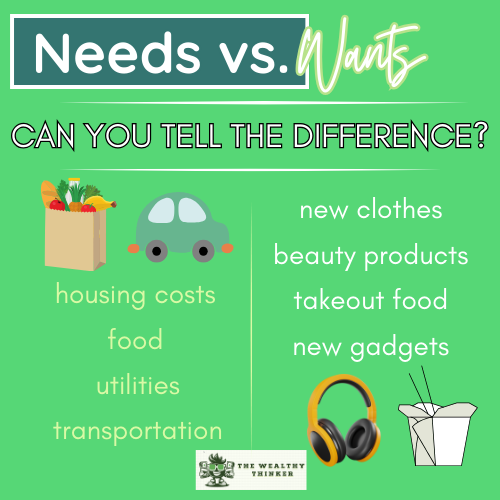There are things that we all need in life, like housing, food, and transportation.
But, conversely, we also want things in life, like new shoes, Starbucks, and subscription boxes.
Distinguishing your wants vs needs will help you understand your priorities regarding your budget and overall financial health.
Knowing the difference will give you a pretty clear view into your spending habits and priorities. And that’s the ticket to creating your budget and setting realistic financial goals.

What are your wants vs needs?
Think about the essential things in life that you need to survive.
What should come to mind are things like shelter, food, transportation, clothes, and utilities. There may be some other things that come to mind too.
Everyone’s essentials will be different. These are your “needs” and should be seen as just the basics to live your life. There are no frills in this area of your life – you need them to survive.
You may think there are other things you need in your life, like:
- new clothes
- makeup
- your weekly brunch
These are not actual needs. They’re important in terms of bringing you joy and improving your lifestyle, and these hobbies or passions can boost your mood and happiness.
But if you didn’t have them, you would be okay. That qualifies a want. If you don’t have a roof over your head, or food to eat, that’s a problem. This qualifies a need.
Wants can also be things that make your life easier, like takeout, subscription boxes, streaming services, and Ride Share services. The wants in your life are important to capture – they can help you build goals. But they’re not things you need to survive.
Why is it important to distinguish wants vs needs?
Your needs and wants in life make up your entire lifestyle.
You want to be able to fund both areas. However, you need to distinguish between these two things to ensure your basic needs are covered before anything else.
- You should budget so your needs are completely taken care of before any other budget line.
- Then, after your needs, or Cost of Living, are accounted for, you can look at your wants and determine what you can afford.
The wants in our lives are much more exciting than our needs, which can sometimes cause us to prioritize them over the truly important things in life.
So many people budget for their wants before their needs and struggle to pay their monthly bills because they’ve already spent all their money.
It is just as essential to be able to afford the things that make you happy in life as it is to be able to pay our monthly bills – but you have to get them in the right order.
How should you use this information?
Personal finance is all connected.
How you spend your money will impact your:
- budget
- savings
- emergency fund
- and more
The same thing applies to what you do with your financial information.
Tracking your spending, creating a cost of living number, and starting a budget all relate to our wants and needs.
When you track your spending, you begin to see your complete financial picture and spending habits. With this financial information, you then have to analyze it.
This is where you break down your spending into wants and needs.
This analysis will help you determine how much you need monthly for your basic survival and where else you want to spend your money.
Once you’ve decided that, you can make a budget to follow through with this decision.
Final Thoughts on Wants vs Needs
Our spending in life is not all equal. Some things we need to spend our money on, like our mortgage or rent.
Other things we can choose to spend our money on to bring us joy or entertainment. While this is all amounts to spending our money, it’s still important to distinguish that spending goes towards specific needs vs wants in our lives.
To successfully understand your budget, you have to start with knowing what your wants and needs are in life.
Then you can use this information to set aside an emergency fund, come up with a savings strategy, or adjust your budget to be able to afford your wants and needs in your life.
Editor’s note: This article was originally published Jul 9, 2022 and has been updated to improve reader experience.















